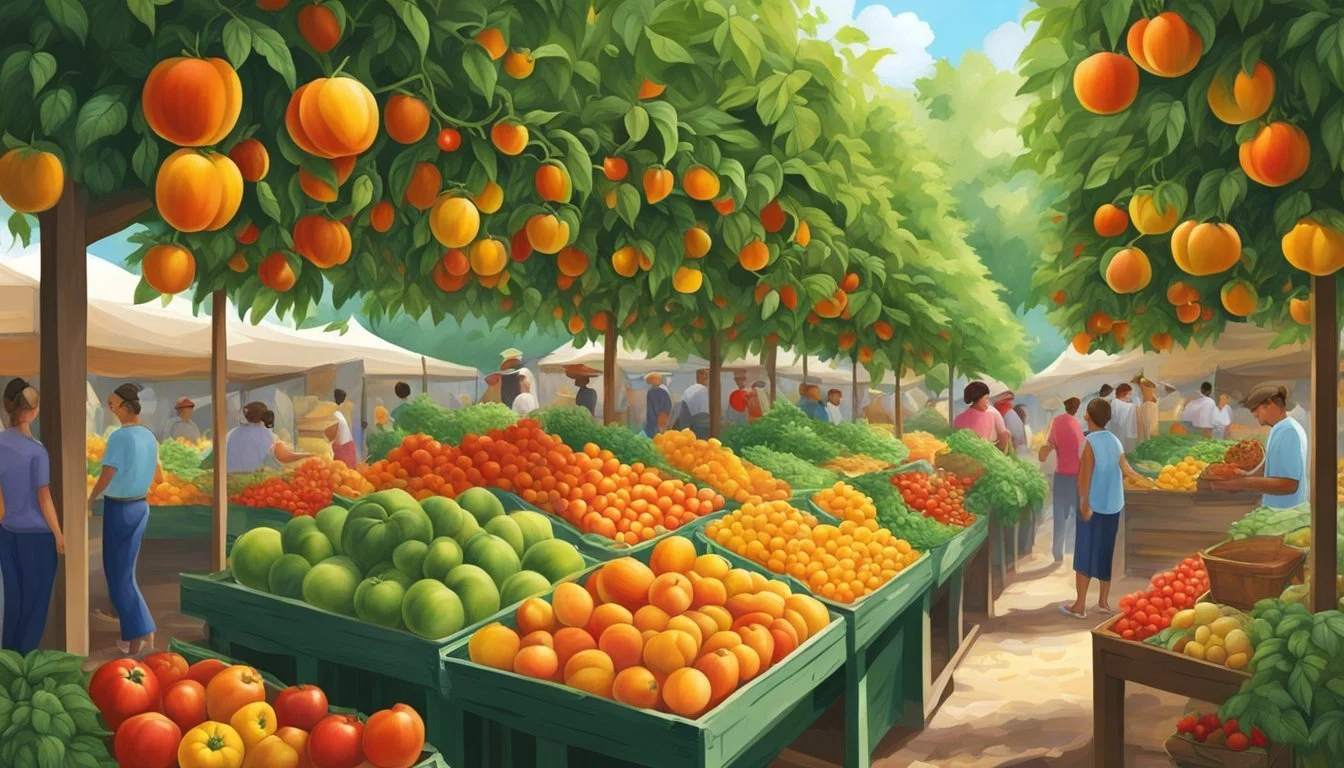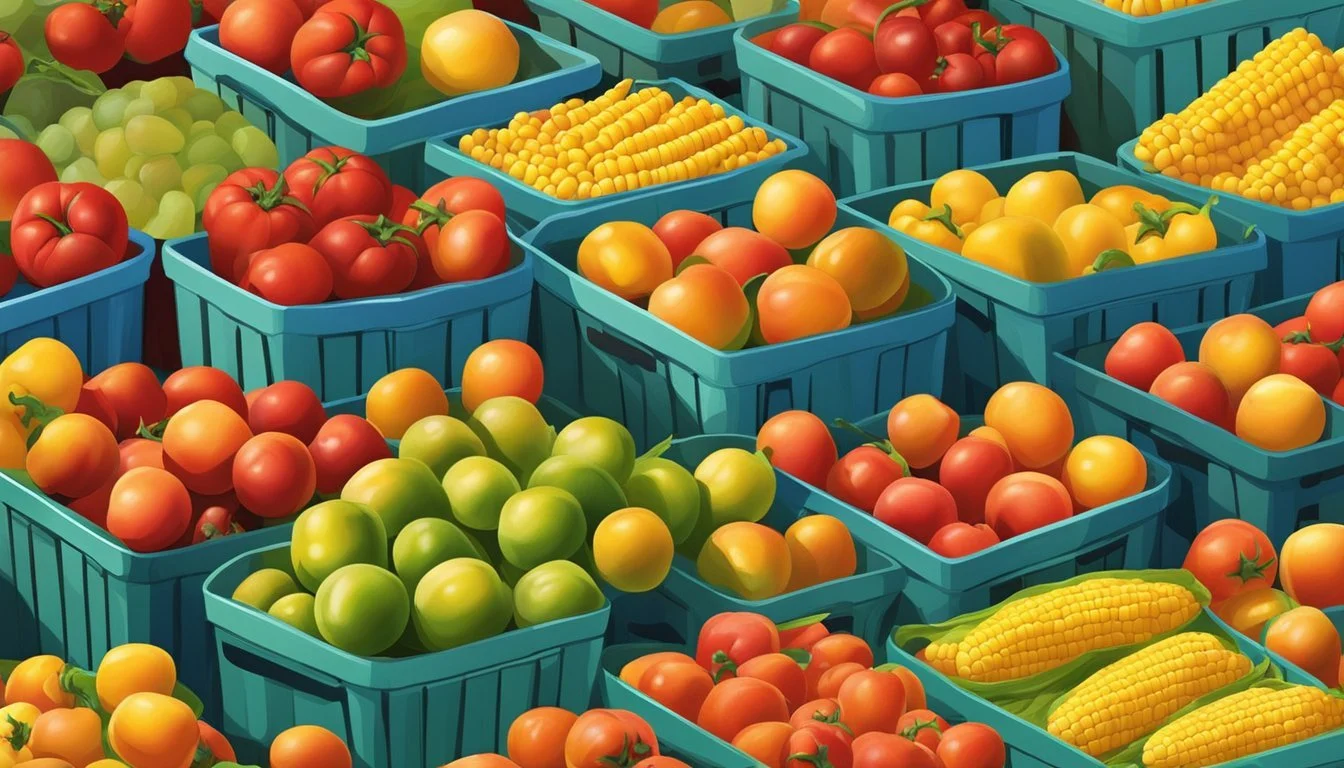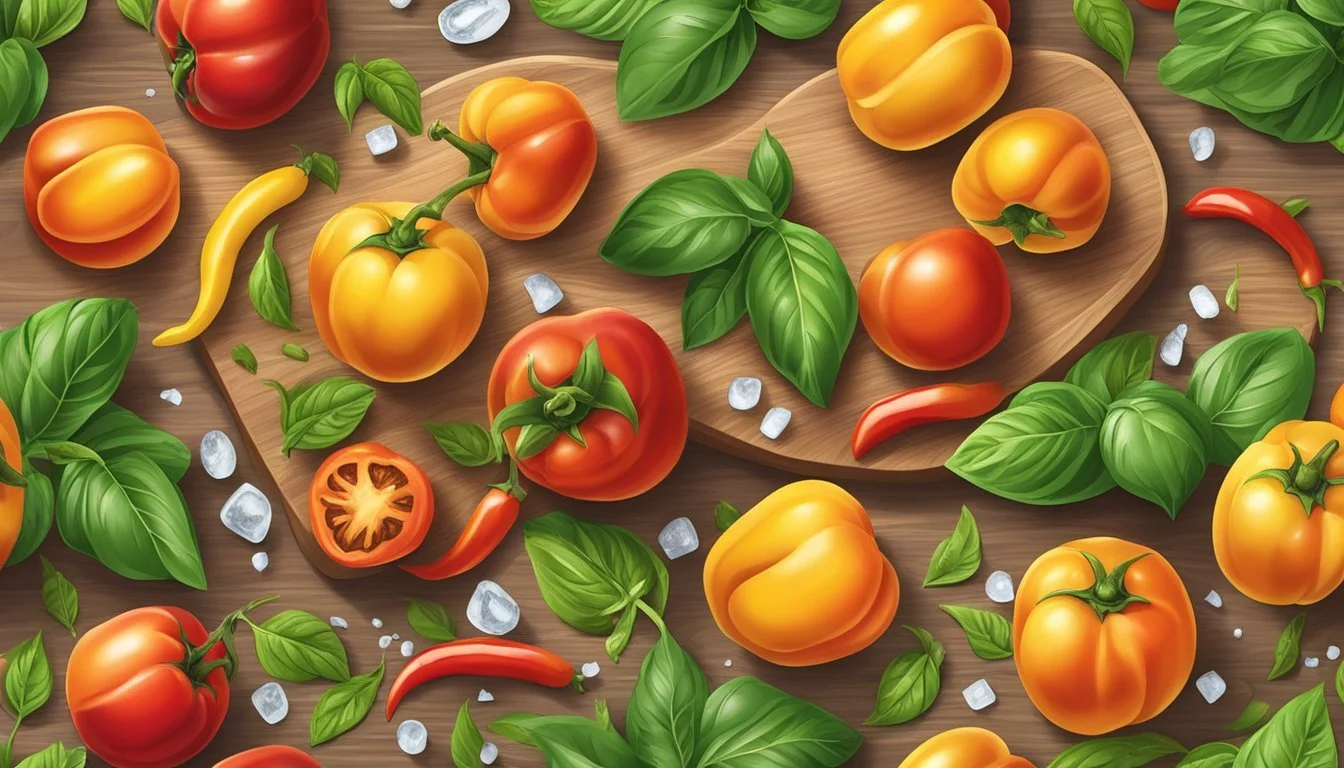Georgia Seasonal Fruit & Vegetables in August
Your Fresh Guide
This Article is Part of our Georgia Seasonal Fruit & Veg Calendar
As August arrives in Georgia, the state basks in the height of its growing season, offering a bounty of fresh fruits (What wine goes well with fruit?) and vegetables. During this warm summer month, local farmers' markets and grocery stores are abundant with produce that has ripened under the southern sun. This seasonality not only ensures peak flavor and nutrition but also supports local agriculture and minimizes the carbon footprint associated with long-distance food transportation.
Among the fruits that take center stage, Georgia's blueberries and cantaloupes (how long does cantaloupe last?) are particularly noteworthy. The blueberry harvest, stretching from May through August, is reaching its end, and the sweet, plump berries are at their best. Cantaloupes, another summer favorite, are also in full swing, offering their juicy, refreshing sweetness to the array of seasonal selections.
Vegetables are not to be overshadowed, with an assortment of vibrant produce available for those looking to enrich their culinary palette. Okra, a staple in southern cuisine, is readily available alongside a variety of peppers; both thrive in the warmth of Georgia's August climate. Root vegetables like carrots have enjoyed the prolonged growing season and come to harvest, while summer squashes add a tender texture to the mix of August produce. This period provides an excellent opportunity for consumers and chefs alike to take advantage of the local and seasonally fresh produce Georgia has to offer.
Overview of Georgia's Seasonal Produce
In August, Georgia's farms bustle with the peak harvest of summer's diversity, yielding flavors that are both rich and fresh.
Summer's Bounty
During August, Georgia's agricultural landscape is abundant with a variety of fruits and vegetables that thrive in the state's warm climate. Peaches are often synonymous with Georgia, and rightfully so, as they reach their juicy zenith. Tomatoes, watermelons, and cantaloupes also share the spotlight, offering refreshing tastes and hydration in the summer heat. Vegetable gardens come alive with sweet corn, cucumbers (how long do cucumbers last?), and green beans.
Here is a brief list of some key produce available in Georgia during August:
Fruits: Peaches, Watermelons, Cantaloupes, Blueberries
Vegetables: Sweet Corn, Cucumbers, Green Beans, Tomatoes, Squash
This is merely a snapshot; Georgia's summer soil nurtures a larger variety than what's listed above.
Importance of Seasonality
Seasonality plays a crucial role in the flavors and nutrition of produce. Farmers in Georgia understand that seasonal produce not only tastes better but also often has a higher nutritional content compared to out-of-season or shipped produce. By August, the sun has worked its magic, and the result is a spectrum of flavors that encapsulate the essence of summer in the state. Picking fruits and vegetables in their prime season enhances the culinary experience, whether they're eaten straight from the vine or incorporated into traditional Southern dishes. Consumers can support the local economy and enjoy superior tastes by choosing seasonal, locally grown produce.
Fruit Harvest in Georgia
August in Georgia is a prime time for a variety of fruit harvests. This period sees the ripening and harvesting of numerous fruits, including stone fruit varieties, a range of juicy berries and melons, as well as other seasonal favorites that provide a fresh taste of summer.
Stone Fruit Varieties
Peaches: Georgia's peaches remain the star of the summer with freestone varieties available in abundance during August. They are ideal for eating fresh or for use in baking and preserves due to their ease of pitting.
Plums: Alongside peaches, plums are also a popular stone fruit reaching peak ripeness this month. They come in an assortment of colors and flavors, from tart to sweet, perfect for snacking or culinary use.
Berries and Melons
Blueberries: August is the tail end of the blueberry season in Georgia, and they are often found fresh and plump, ready for picking.
Blackberries (how long do blackberries last?): Blackberries continue to be harvested in early August, offering a balance of sweet and tart flavors, enjoyed on their own or in desserts.
Cantaloupe: A sweet, musky staple of summer, cantaloupe is in full swing, with Georgia-grown varieties being particularly flavorful.
Watermelon: Synonymous with summer, the Georgia watermelon harvest is in peak season, providing refreshing, juicy slices perfect for hot August days.
Other Seasonal Fruits
Other fruits commonly harvested in August may include figs and muscadines, each with their own distinctive sweet flavors that add diversity to the summer fruit bounty in Georgia. These fruits often make appearances at local markets and are cherished for their unique taste and culinary versatility.
Vegetable Picking in August
In Georgia, August ushers in a hearty selection of vegetables ripe for picking. Gardens and fields offer a variety of roots, gourds, and legumes, ensuring a bountiful harvest.
Roots and Bulbs
Tomatoes: August's warmth brings tomatoes to perfect ripeness; look for firm, deeply colored specimens.
Cucumbers: These should be uniformly green, firm, and medium-sized for peak freshness.
Squashes and Gourds
Zucchini: They are at their best when small to medium in size, with glossy skins.
Squash: Varieties like yellow squash and pattypan are plentiful, with a buttery flavor and tender texture.
Eggplant (What wine goes well with eggplant?): Choose those with smooth, shiny skins and a slight give when pressed.
Legumes and Pods
Beans: Snap beans, like green and wax beans, should be firm and crisp.
Okra: The pods are best when small to medium size, as larger ones may be tough.
Peppers: They come in many varieties; bell peppers should have bright, taut skins without wrinkles.
Corn: Ears should have bright green husks and plump, juicy kernels that pop when pressed.
Freshness and Preparation
In Georgia, August's bounty of fruits and vegetables is at its peak. Proper handling and preparation can preserve their freshness and flavor.
Preserving Fresh Produce
Canning is a tried-and-true method that extends the life of produce like peaches and tomatoes. Peaches can be canned as halves or slices in syrup, perfect for enjoying year-round. Tomatoes are often canned to create a base for spaghetti sauce or salsa, locking in their ripe flavors for colder months.
For vegetables such as okra and cucumbers, pickling is an excellent preservation method. It not just maintains freshness but also adds a tangy flavor, making for delicious pickles that can be enjoyed as snacks or added to dishes.
Freezing is another effective option, ideal for blueberries and field peas. Freezing these items at their freshest ensures that one can savor the taste of summer even in the winter. Vegetables like bell peppers and squash can be cut into pieces and frozen for later use in a variety of recipes.
Simple Seasonal Recipes
Taking advantage of August’s fresh produce, simple recipes allow the natural flavors to shine through. One can make a vibrant salsa using fresh tomatoes, peppers, and herbs. It's both a refreshing accompaniment to grilled dishes (What wine goes well with grilled dishes?) and a flavorful mix for tortilla chips.
Sweet potatoes (What wine goes well with sweet potatoes?) and eggplants lend themselves beautifully to dishes like baba ganoush, a savory spread that pairs well with flatbreads and vegetables. Preparing this dish with fresh eggplant from the garden will result in a richer and more authentic flavor.
Creating jams from blackberries and muscadine grapes is a delightful way to capture the essence of Georgia’s August fruits. Homemade jam not only serves as a delicious spread for morning toasts but also as a sweet reminder of summer's freshness throughout the year.
Georgia's Food Culture and Seasonal Cooking
Georgia's food culture is deeply rooted in local produce and traditional recipes. August's harvest brings the flavors of fresh fruits and vegetables to the table, inspiring seasonal dishes that reflect the state's rich culinary traditions.
Local Culinary Traditions
In Georgia, culinary traditions are often centered around the use of fresh, local produce. August brings a plethora of produce, including cantaloupes, cucumbers, eggplant, and notably, the last pickings of the state's famous peaches. These ingredients become the stars of Georgian cuisine, which is known for its emphasis on freshness and simplicity. For instance, the flavors of just-picked tomatoes and sweet onions are often combined to create a refreshing summer salad.
Seasonal Dishes Showcase
The showcase of seasonal dishes in August often includes vibrant flavors and combinations, such as the tang of balsamic in a tomato salad or the sweetness of sugar in homemade berry pie. The savory dishes might highlight the earthiness of local parm paired with fresh vegetables like eggplant and squash. Here is a snapshot of two indicative seasonal dishes:
Peach and Berry Pie: A staple dessert that captures the essence of Georgia's August fruits, merging the sweetness of the last peaches with the tartness of fresh berries, complemented by a hint of sugar and encased in a flaky crust.
Eggplant Parmesan (What wine goes well with eggplant parmesan?) with Local Herbs: A showcase of summer vegetables, it pairs the creaminess of melted parm with crispy, balsamic-glazed eggplant slices and herbs from local gardens.
Each dish represents Georgia's seasonal rhythm, emphasizing the state's celebration of its bountiful August harvest through flavors that are both bold and refined.
Planning Ahead: Fall Produce Preview
As the summer warmth wanes, Georgia's farms are preparing for the fall harvest. This season brings a new bounty of fruits and vegetables, each with their own ideal planting times and nutritional benefits.
Upcoming Fruits
Apples: A fall staple, Georgian apple orchards become ripe for picking in the early fall. One can expect a variety of apples to be available, including crisp favorites suitable for both eating fresh and for baking.
Next Season's Vegetables
Arugula: (how long does arugula last?) This peppery green often hits its stride in the cooler months. For fall salads, arugula provides a flavorful base, perfect to pair with the season's harvest.
Broccoli: Robust and hearty, broccoli thrives in cooler weather. When planted in August, it matures to provide nutrient-rich florets ideal for autumn meals.
Cabbage: A versatile vegetable, cabbage sown now will be ready to harvest in the fall. It serves well in both raw salads and cooked dishes, adding texture and vitamins to the diet.
Sweet Potatoes: A southern favorite, sweet potatoes planted during the late summer can be harvested throughout the fall. Once ready, they offer a starchy, nutritious addition to any meal.







